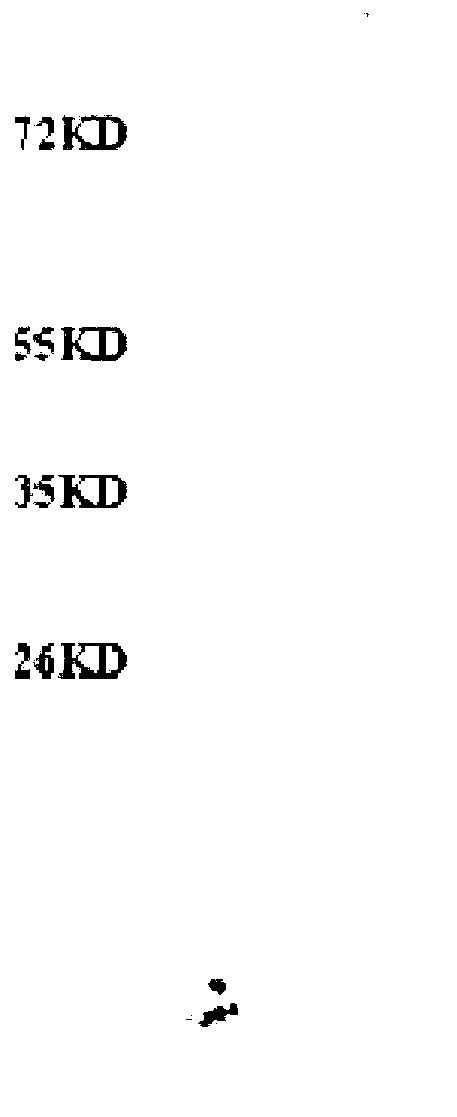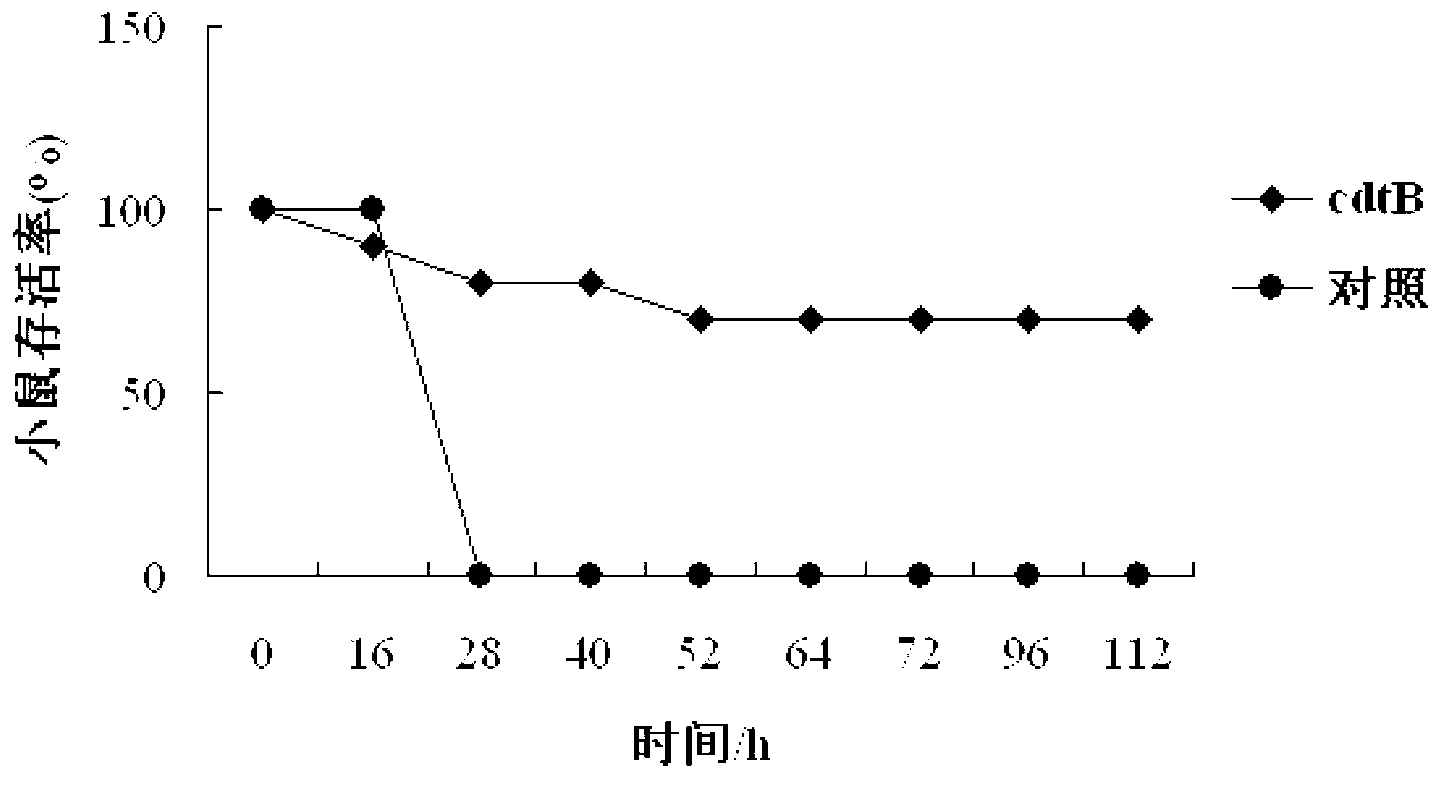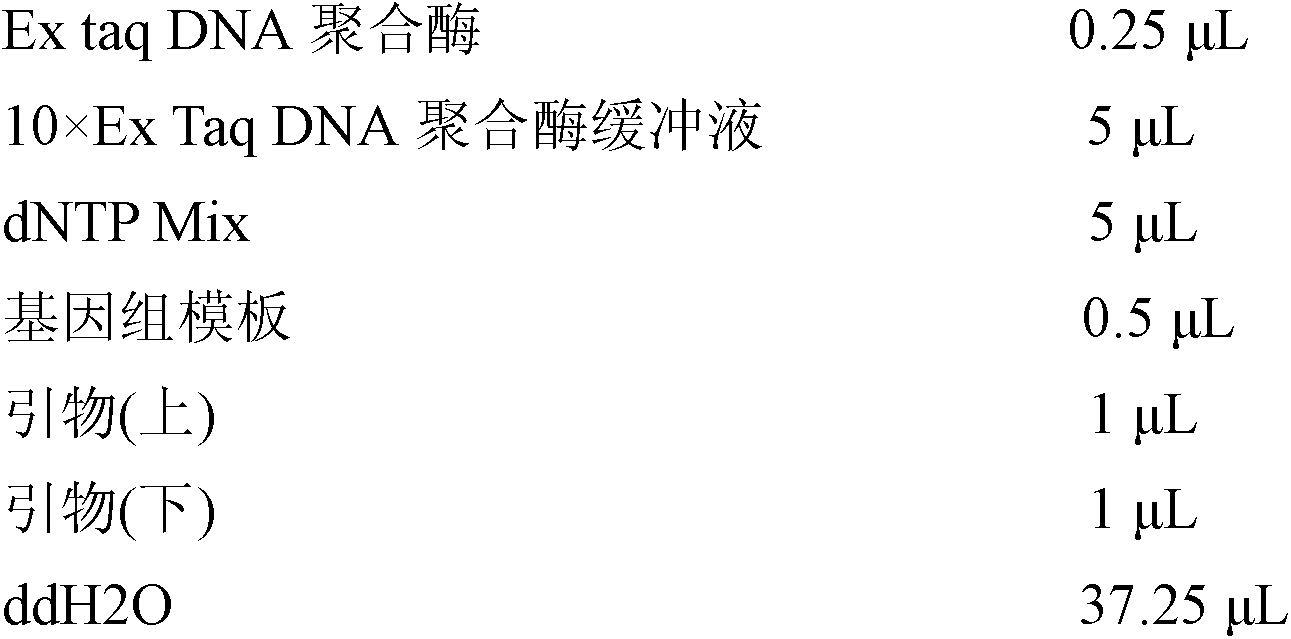Haemophilus parasuis (Hps) immunoprotecive antigen CdtB
A technology of Haemophilus suis and protective antigen, which is applied in the field of animal infectious disease subunit vaccine preparation, can solve the problems that it cannot cause the expansion and apoptosis of target cells, and the whereabouts are not clear.
- Summary
- Abstract
- Description
- Claims
- Application Information
AI Technical Summary
Problems solved by technology
Method used
Image
Examples
Embodiment 1
[0032] Embodiment 1, the cloning of CdtB protein coding gene
[0033] 1. Extraction of total Hps DNA
[0034] Centrifuge 1 mL of the overnight culture solution of Haemophilus parasuis (Hps) (purchased from the National Center for Veterinary Microorganisms, strain number: CVCC3361) at 12,000 rpm for 1 minute, and discard the supernatant. Add 40 μL DB solution (TIANamp Bacteria DNA Kit, Tiangen Biological Co., Ltd.), 160 μL lysozyme and 8 μL RNaseA to the cell pellet. Shake vigorously to mix well. Incubate at 37°C for 30-60 minutes, and invert the centrifuge tube several times. Add 200 μL of DLT solution (TIANamp Bacteria DNA Kit, Tiangen Biological Co., Ltd.) and 25 μL of proteinase K (TIANamp Bacteria DNA Kit, Tiangen Biological Co., Ltd.), and immediately mix it gently by inversion. Place in a 65°C water bath for at least 30 minutes, and invert the centrifuge tube several times. Centrifuge at 12000rpm for 3-5 minutes, and pipette all the supernatant into a clean centrifug...
Embodiment 2
[0053] Embodiment 2, expression and purification of CdtB protein
[0054] 1. Preparation and purification of CdtB protein
[0055] Cultivate the engineered bacteria prepared in Example 1 (IV) in LB medium containing 50 μg / ml kanamycin, and culture at 37°C for 3h; when OD600=0.7, add IPTG to a final concentration of 0.8μM, and transfer to 37°C Continue to cultivate for 4h.
[0056] Collect the bacteria by centrifugation at 5000rpm for 10 minutes, suspend in the solution in PBS, and ultrasonically break in an ice bath (300w, 10 minutes; ultrasonic for 3s, stop for 5s), then centrifuge at 15000rpm for 10 minutes to collect the precipitate, and dissolve the precipitate with 30ml of solution A ( NaH 2 PO 4 100mmol / L, Tris-HCl10mmol / L, 8mol / L urea to adjust the pH to 8.0) to dissolve, and can be briefly ultrasonicated to induce dissolution. Add 2 mL of pre-treated resin (Ni-NTA His-Bind Resin, Novagen), shake at a low speed at 4°C for 30 minutes to fully combine the resin with t...
Embodiment 3
[0061] Example 3, Identification of CdtB Protein Immunoprotection
[0062] 1. Effect of Hps on LD of Kunming mice 50 Determination of
[0063] Inoculate Hps (purchased from the National Center for Veterinary Microorganism Culture Collection, strain number: CVCC3361) in TSB liquid medium (containing 10% horse serum, 0.01% NAD) at 37°C at 200 rpm / min for 14 to 16 hours, and then the next day Spread TSA solid medium (containing 10% horse serum, 0.01% NAD) and incubate at 37°C for 24-36h. Wash the bacterial lawn with PBS and dilute to 5×10 8 CFU / mL (OD 600 about 1.0), then 2-fold concentrated step by step, concentrated to the required dose (as shown in Table 1) and then injected into mice. Female Kunming mice aged 8-10 weeks (purchased from the Experimental Animal Center of Harbin Veterinary Research Institute, Chinese Academy of Agricultural Sciences) were divided into 5 groups, 10 mice in each group. Each mouse was intraperitoneally injected with 100 μL of the challenge dru...
PUM
| Property | Measurement | Unit |
|---|---|---|
| Molecular weight | aaaaa | aaaaa |
Abstract
Description
Claims
Application Information
 Login to View More
Login to View More - R&D
- Intellectual Property
- Life Sciences
- Materials
- Tech Scout
- Unparalleled Data Quality
- Higher Quality Content
- 60% Fewer Hallucinations
Browse by: Latest US Patents, China's latest patents, Technical Efficacy Thesaurus, Application Domain, Technology Topic, Popular Technical Reports.
© 2025 PatSnap. All rights reserved.Legal|Privacy policy|Modern Slavery Act Transparency Statement|Sitemap|About US| Contact US: help@patsnap.com



